Dual Warfield 8 inch series-wound motors. (225 lbs.) Motor high current wiring returned to being configuarable in either series or parallel wiring.
Direct drive. Motor shafts connected with splined coupler between front and rear motors. Electric reverse.
Two piece driveline with center carrier bearing. Front and rear driveline loops.
'57 Ford nine inch axle setup out of a V8 Chevy LUV minitruck. 4:57 gears. Locked minispool. Air shocks & traction bars.
Front - Eagle 5 spoke 13 x 5.5 alloys with 4 bolt Nissan rear drive offset and 175/50/13 Nitto Exit GS radials.
Rear - Eagle 5 spoke 14 x 6 alloys with 5 bolt Ford front drive offset and DOT street legal Nitto 'Extreme Drag Radials' (22" dia.).
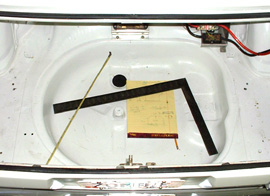
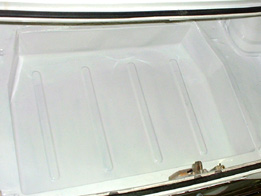
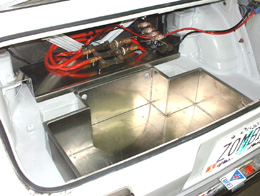
Complete redesign of the battery system, with all metal work done by Marko Mongillo. An all new trunk floor compartment (center) shaped to hold batteries instead of a tire, was built to replace the factory kidney-shaped spare tire well (left), then it was welded-in and painted to match the car's finish. A new aluminum battery box was then fitted into the new battery well (right).
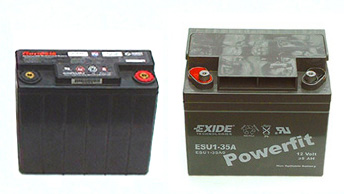
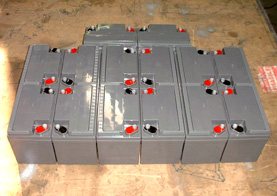
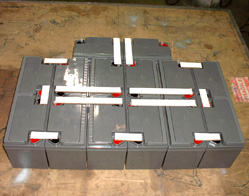
These mods were done to facilitate a battery change from the tired, small 16 ahr Hawkers, to 28 brand new larger sized 12 volt Exide 'Power Fit' 35 ahr, 26 lb. batteries. Pack at 336V nominal and much heavier at 720 lbs. total pack weight. The first photo shows the size increase from the little Hawkers to the larger Exides. Before installing the these batteries, e had to figure how to make them fit, then how to inter-connect them with bus bars in a bench-top mock-up.
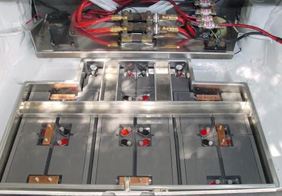
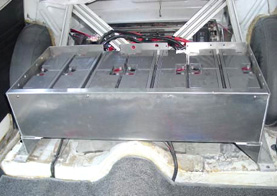
The photos below show all 28 of the new batteries installed but not yet fully wired up. (left) Note the 'Bubba' high current contactor on the metal plate above the batteries (11:00 position). It was taken out of the previous back seat small Hawkers battery pack enclosure, where it was used split the compact 336V pack for dump charging, and was retained for use with this new heavier pack setup and wired up to accomplish the same task. (right) Remarkably, 1/2 the total number used in the pack, 14 of these bigger batteries, fit perfectly inside the existing rear seat area aluminum battery tray that used to hold all 28 of the previous small Hawkers, so a new enclosure did not have to be made.
Godzilla 1200 amp programable controller. Series-parallel contactor shifting returns with steering wheel thumb button control.
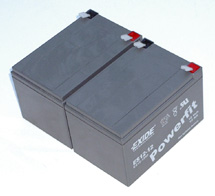

Removed the 6 year old baby Optima YT and replaced it with twin Exide 12V, 12 ahr small AGM batteries. No DC-DC - external charging required.
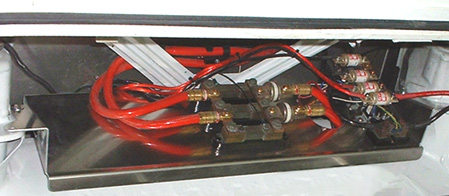
Created a new behind-the-seatback-bulkhead area aluminum plate that spanned across the area from fender well to fender well, and remounted the previous traction pack fuses, the charger/relay setup, and the pack splitting Bubba contactor (contactor not yet mounted, see above batteries photo).
2379 lbs. (est)
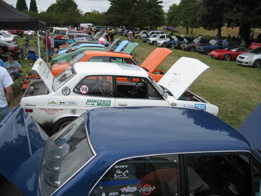
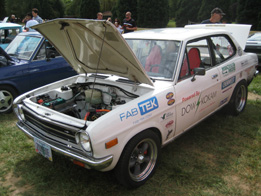
6-8-2003 'NW Datsun Owners Association' show & shine picnic...White Zombie on display.
8-31-2003 Woodburn Nationals...two non-completed runs, no ETs.
Grey 'Power Fit' batteries threw a fit, and were a total failure. One blew up on the first attempt at the start line. After installing a fresh battery, two more batteries blew up on the second and last attempt at the start line. Due to the last minute availability of these batteries I was not able to get reliable current ratings for them. After the races, I learned the batteries had a maximum rated discharge current of 350 amps for 5 seconds. The first run was with the controller's battery input current set to 800 amps. We turned the controller current down to 500 amps for the second (and last) run of the day, but the batteries still blew up.
"Having a powerful EV that also doesn't come off as a rolling science project, is far more important than 'winning'. It's easy to make a machine from orange board, duct tape, and hastily-made metal pieces that weighs next to nothing and doesn't even look like a 'car', then run it down the track to set a speed record. It's far harder to take a recognizable street bodied car and do the same thing."